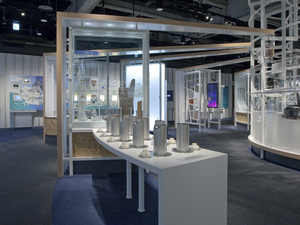Nagoya City Science Museum
TOP > Exhibition Guide > Keyword Search > Starting with "F" > flavour > Flavours and Fragrances
Flavours and Fragrances



Purpose of Exhibition
Flavor and fragrance is utilized everywhere in our daily lives. All flavors and fragrances are artificially produced. The ten kinds of flavor and fragrance which you will experience in this exhibition are synthetic fragrances. Please try them for yourself.
Additional Knowledge
[Natural Fragrance]
The history of fragrance is very old, and is considered to date back to four thousand or five thousand years ago. We purified ourselves with perfume, used it for food preservation and its sterilization effectsNatural flavors can be divided into animal and vegetable. There are only a few animal originated perfumes.
In recent years, some natural fragrances were obtained from meat and seafood. Most fragrances originate from vegetables, flowers, fruits, bulbs, leaves, stems and roots and different parts of raw material.
From these and by steam distillation and press, the flavor components and solvents (essential oils) are extracted.
[Natural flavor and fragrance exhibited]
- Musk: portions of male musk deer which inhabits in the Himalayan mountains, Nepal or in the Kingdom of Bhutan and the Yunnan Province, China. It has an unpleasant odor, which turns good when dried.
- Ambergris: a kind of stone found in sperm whale stomach and intestines. It smells sweet. It was considered to be a drop of a dragon's drool from its mouth in China. That is why it was named after it. - Cat incense spirit (civet): cat's gland secretion from the musk cat in Ethiopia, scraped with a spatula and stored into horns (on display); a terrible smell, but will turn to fragrance when diluted. - Beaver (Castoreum): an incense bag, which is dried near a beaver's anus. - Olibanum (frankincense): From the frankincense trees in the mountains of east Africa and south Arabia, hardened sap burned and used in religious ceremonies since ancient times. Has a strong germicidal effect and was used in the making of mummies.
- Agarwood: It sinks into the water and so it was named after it. Among Agarwood fragrances, some luxury goods are called aloes wood. The tree called "Ranjyatai" in Shousou-in, Nara, is its representative. - Sandalwood (sandalwood/sandalwood): Sandalwood perfume is extracted from root stems, the scent of sandalwood is fan scented.
[Synthesis of flavor and fragrance]
Synthesis of flavor and fragrance utilizes chemical reactions of the materials such as oil and raw oil. When you produce a mixture of flavor and fragrance, you first start to examine the components of natural flavor and fragrance and investigate them. For example, the flavor of jasmine is composed of about 150 kinds of components. You examine the structure of particles in each component, mix its component from another material, and produce flavor.
A number of flavors and fragrances which are utilized in food and make-up are a mixture of them, and do not consist of one kind of component.
Furthermore, it smells quite differently depending upon whether it is thick or thin. Skilled people with a talent for smelling, select and mix flavor and fragrance necessary from thousands of mixtures of flavor and fragrance (also natural), and produce flavors and fragrances for their purposes.
[Flavor and particles]
Flavor molecules are volatile small molecules that float in the air, and therefore we can smell. By adhering to the olfactory cells of the nose, we can smell. Many types of fruit have an ester bond and many small particles. Similar molecular structure is said to be relatively common in fragrance.
On the other hand, with a tiny different structure, it may have a totally different smell. This is the deep world of fragrances.
Cooperation: TAKASAGO INTERNATIONAL CORPORATIONArticle by Keiko Ishida, curator
